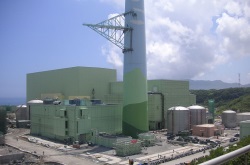The Lungmen nuclear power plant could be in operation by the end of this year or early next year, according to reported statements from Taiwanese planners.
 |
| Lungmen 1, pictured in August 2009 |
Technology newspaper Digitimes reported the Ministry of Economic Affairs as saying said a batch of systems tests at Lungmen 1 should be finished by April, with 'full testing' complete by the end of June. Loading of nuclear fuel is expected in September, said direct quotes from the ministry. This indicates start up and commercial operation towards the end of 2014 or early 2015.
The two Advanced Boiling Water Reactor units at Lungmen in the north of the island have had a troubled history. The first unit started construction exactly 16 years ago on 10 January 1998. Taipower's initial plan had been to secure one main contractor for engineering, procurement and construction of the units, but this failed and instead it awarded separate contracts to GE for the nuclear reactors, Mitsubishi for the turbines and various other contractors for the remainder. In 2011 Taipower was heavily criticised by the national regulator, the Atomic Energy Council, for its management of the difficult arrangement.
When the two reactors were about one-third complete, a new cabinet cancelled the project and triggered a year-long delay that eventually ended with a government resolution in favour of construction. This hiatus, plus project management and engineering problems, pushed up the projected cost significantly. Last year a vote on whether to hold a referendum on the future of the plant descended into a brawl between opposing parties.
When in operation the Lungmen units will produce 1350 MWe each and take nuclear power's share of power generation on Taiwan to around 20% compared to the 17% that six reactors produce now. These units are only allowed a 40-year lifespan under current energy policies, which means the oldest units, at Chinshan, would close in 2018 and 2019.
Researched and written
by World Nuclear News




_91467.jpg)
_47120.jpg)
_16439.jpg)






